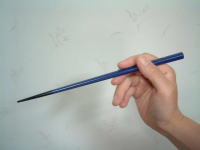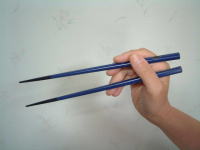 |
CHOPSTICKS
( HASHI )
 |
Now in the world, it is said that approximately 30% of the people use chopsticks,
also 30% of the people use knives and forks,
and the other 40% of the people eat by hands.
Of course depending on the country or the person the custom is different,
but generaly in East Asia, people use chopsticks because they eat sticky
rice.
It is a well-known story that Louis XIV in France ate by using his hands.
At that time some nobles gradually started to use forks and spoons,
but it appears that before the 18th century generally
a roasted chunk of meat was carved for dinners and they had to eat with
their hands
Anyway when human beings started to use fire to cook foods,
they needed tools to stick or pinch or scoop
to get foods from the fire or to eat hot foods.
Chopsticks have an extremely long history compared with other utensils.
As we have various views about the real origin or history of chopsticks,
it is difficult to know about them.
In China bronze chopsticks were discovered from
excavations of old capital during BC14-BC11.
They are the oldest existing chopstics so far and they were probably
not tools to eat but used for formal ceremony.
In Japan, there are several opinions about the origin of chopsticks.
Some say that chopsticks were introduced from China in the middle of the
6th century
and others say that they were introduced early in the 7th century.
Anyway in the early Nara period (710-784) people started to use chopstics
in daily life and changed the way of eating.
Now Japanese usually use shorter chopsticks than the ones used by the Chinese.
Chopsticks are commonly made of light but strong materials
like wood, bamboo or plastic in Japan
They have many functions.
Japanese use them sometimes like forks or knives.
In many resturants, disposable chopsticks or waribashi are provided.
However these have to be splits apart before they are used.
They are made of bamboo, Japanese willow or thinned-out timber
and are not encased in lacquered or decorated.
Do not smooth disposable chopsticks by rubbing them against each other.
If you find that both sides of the chopsticks are tapered,
and put in a beautiful paper bag,
this is called"Iwai-bashi "
These are usualy used during happy occasions.
Long chopstics are called Saibashi, and are used for cooking.
******************
| Know your proper length of Japanese chopticks |
|
| Your heght | Proper length |
| 155cm | 21.5cm |
| 160cm | 22.0cm |
| 165cm | 22.5cm |
| 170cm | 23.0cm |
| 175cm | 23.5cm |
| 180cm | 24.0cm |
There is rough correlation between height and hand-size.
********************
***** HOW TO OPERATE CHOPSTICKS *****

THE RIGHT WAY TO HOLD CHOPSTICKS
 |
 |
| �@ hold the upper stick in one hand as a pencil is held |
�A�@ the lower stick is supported by the ball of the thumb and the ring finger |
***** TABOOS *****